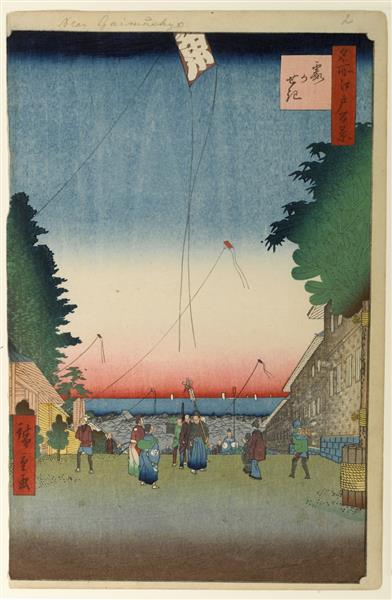Opis
Obraz "2. Kasumigaseki - 1857" autorstwa Utagawy Hiroshige to dzieło, które uchwyca istotę ukiyo-e, stylu, który rozkwitał w Japonii w okresie Edo, charakteryzującego się przedstawieniami krajobrazów, aktorów teatru kabuki oraz scen z życia codziennego. Hiroshige, jeden z najbardziej znanych mistrzów tego gatunku, osiąga wyjątkową maestrię w użyciu koloru i kompozycji, co nadaje temu dziełu niepowtarzalną i głęboko poruszającą atmosferę.
W "Kasumigaseki" scena umiejscowiona jest w naturalnym otoczeniu, które jednocześnie budzi poczucie spokoju i dynamizmu. Tytuł dzieła odnosi się do dzielnicy w Tokio, znanej ze swojej piękności i krajobrazów. Artysta łączy poczucie ruchu z ciszą krajobrazu, tworząc równowagę, która zaprasza widza do kontemplacji nie tylko samego dzieła, ale także do refleksji nad interakcją między człowiekiem a naturą. Kompozycja jest starannie zbudowana; elementy krajobrazu są zorganizowane w taki sposób, aby prowadzić wzrok widza przez obraz. Na dole można dostrzec postacie ludzkie, chociaż nie są one centralnym punktem obrazu. Jednak ich obecność nadaje poczucie skali i połączenia z otoczeniem, sugerując obecność człowieka w rozległym naturalnym krajobrazie.
Kolory w "Kasumigaseki" są szczególnie godne uwagi. Hiroshige używa zróżnicowanej palety, obejmującej delikatne i subtelne odcienie, które przechodzą od błękitów nieba i wód do głębokich zieleni roślinności. To użycie koloru nie tylko ustanawia atmosferę dzieła, ale także generuje głębię wizualną, która zaprasza do kontemplacji. Przezroczysty błękit nieba, w połączeniu z cieniami gór w oddali, tworzy niemal eteryczny efekt, który podkreśla mistrzostwo Hiroshige w reprezentacji naturalnego światła. Dodatkowo, ziemiste odcienie zastosowane w pierwszym planie równoważą paletę, wprowadzając ciepło, które kontrastuje z chłodnością bardziej zimnych kolorów.
Dzieło to jest także doskonałym przykładem zastosowania perspektywy w ukiyo-e. Hiroshige stosuje techniki głębi, które zapraszają widza do zanurzenia się w scenę, osiągając niemal trójwymiarowy efekt mimo dwuwymiarowości medium. Strukturalne linie drzew i horyzontu są ułożone w taki sposób, że tworzą otaczającą atmosferę.
Hiroshige często inspirował się naturą i codziennym życiem Japonii, a "Kasumigaseki" nie jest wyjątkiem. Poprzez swoje dzieło artysta nie tylko uchwyca konkretny moment w czasie, ale także łączy to przedstawienie z bogatą tradycją kulturową, która celebruje efemeryczne piękno życia. Styl Hiroshige, który często włącza elementy japońskiego krajobrazu, można znaleźć w innych jego dziełach, takich jak seria "Sto widoków Edo", gdzie krajobraz i kultura miejska przeplatają się w równie fascynujący i subtelny sposób.
Podsumowując, "2. Kasumigaseki - 1857" to więcej niż tylko prosta reprezentacja krajobrazu; to refleksja nad harmonią między człowiekiem a naturą, przedstawiona przez wyjątkowe umiejętności Hiroshige. Każdy detal w dziele, od starannego doboru kolorów po organizację elementów kompozycyjnych, ukazuje głębokie połączenie artysty z jego otoczeniem oraz jego zdolność do wizualnego wyrażania tej więzi w sposób uderzający. To dzieło pozostaje trwałym świadectwem znaczenia i piękna tradycji ukiyo-e, a także artystycznej mistrzostwa Utagawy Hiroshige.
KUADROS ©, słynny obraz na twojej ścianie.
Reprodukcje obrazów olejnych ręcznie wykonane, z jakością profesjonalnych artystów i charakterystycznym znakiem KUADROS ©.
Usługa reprodukcji obrazów z gwarancją satysfakcji. Jeśli nie będziesz całkowicie zadowolony z repliki swojego obrazu, zwrócimy Ci 100% pieniędzy.

